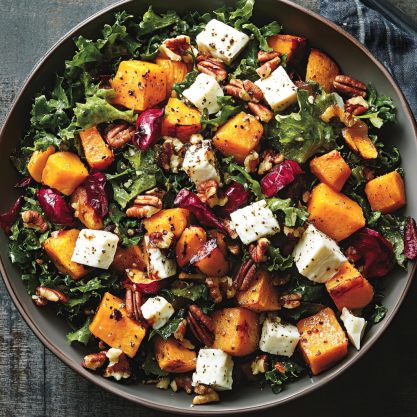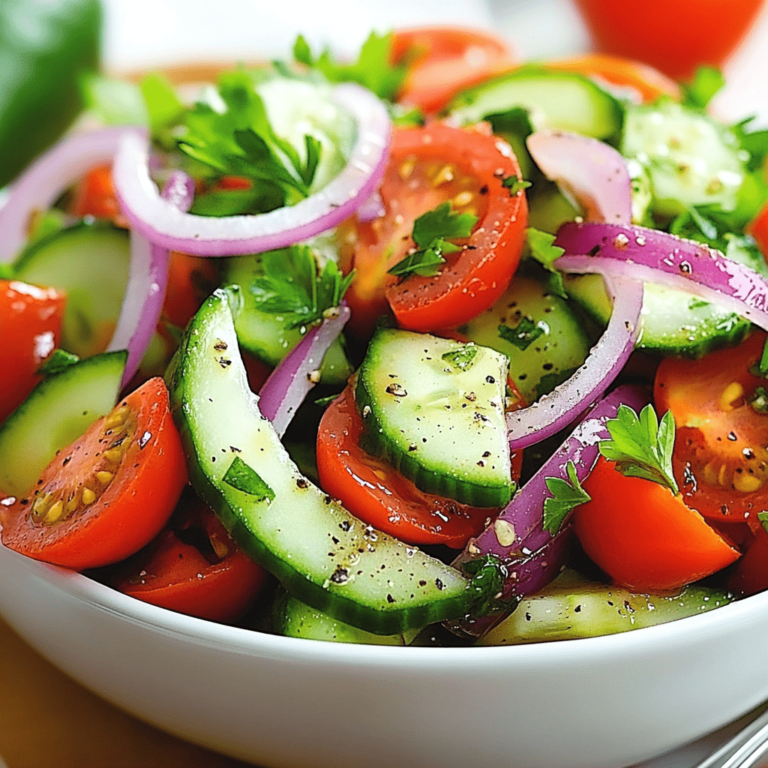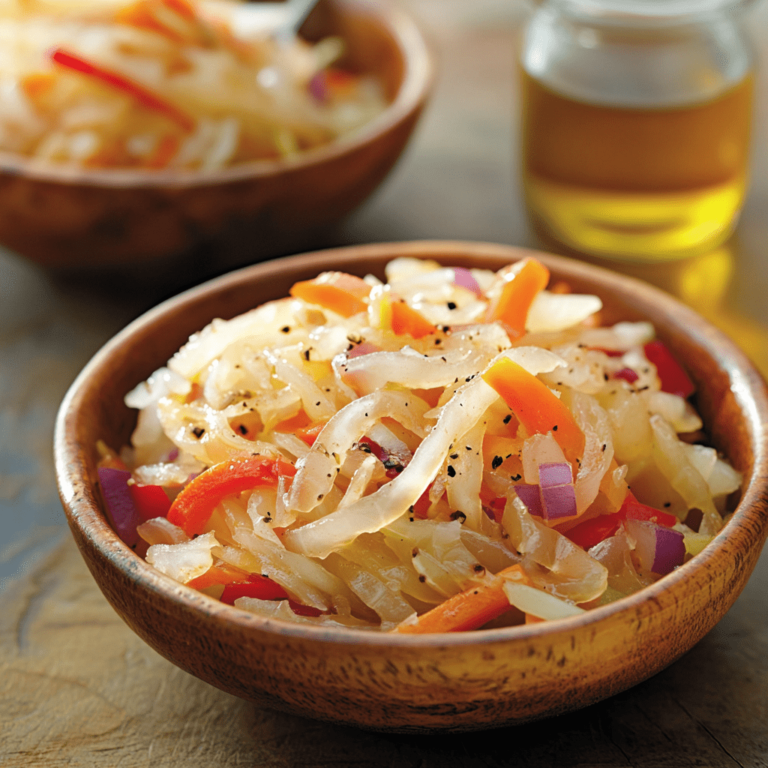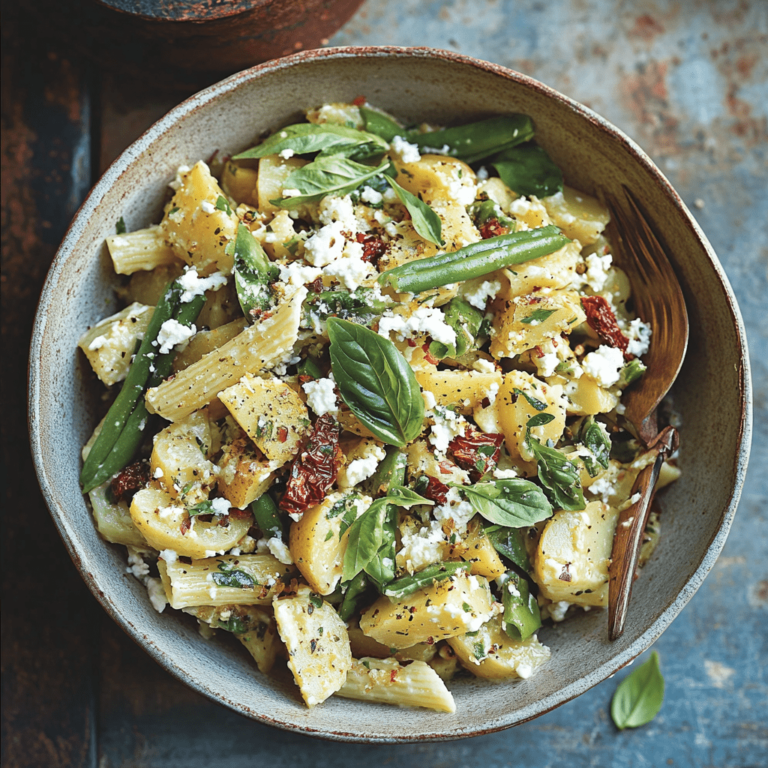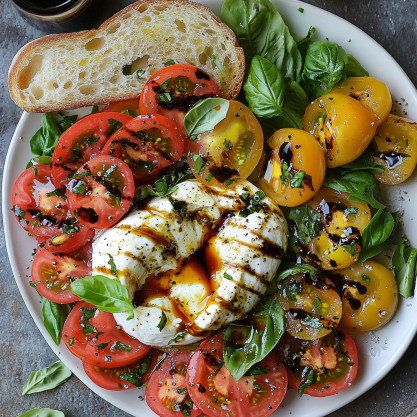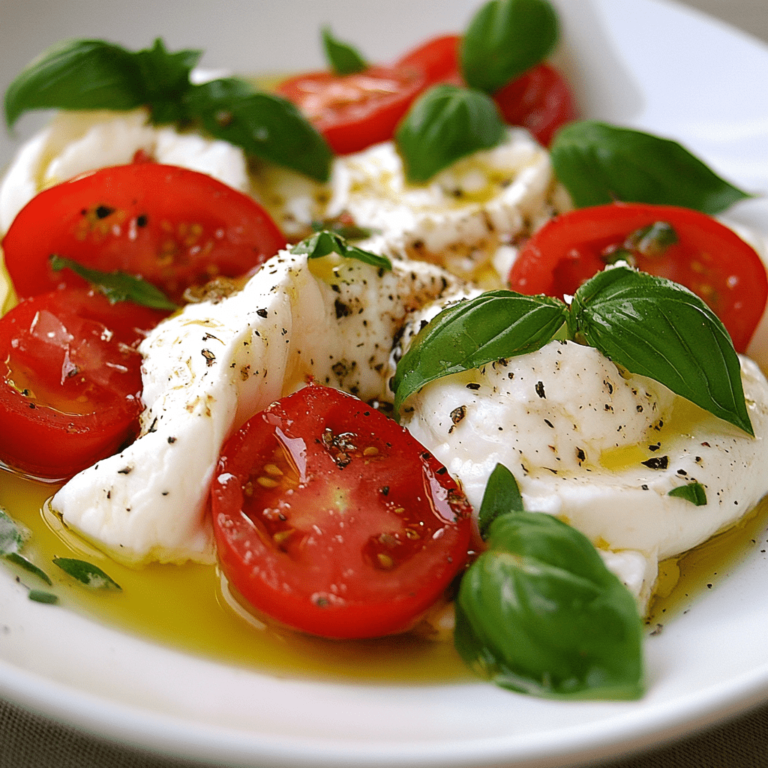Garden Salad A Fresh Summer Recipe Easy Homemade Dish
Looking for a light meal for those hot summer days? A garden salad is perfect. It’s fresh, delicious, and easy to make. This dish highlights the season’s best, with crisp greens and colorful veggies.

Perfect for a backyard barbecue or a quick lunch, our garden salad is ideal. You can customize it with your favorite ingredients or what’s in season. Get ready to enjoy a bowl of summer freshness!
Garden Salad: A Fresh Summer Recipe
Garden salads are perfect for summer. They’re refreshing, nutritious, and use fresh produce. They’re a great addition to your menu.
The Perfect Garden Salad
A great garden salad starts with fresh ingredients. Use leafy greens like romaine or spinach. Add juicy tomatoes and crunchy cucumbers.
Colorful bell peppers add crunch and flavor. The goal is to mix different textures and tastes in each bite.
Benefits of Homemade Salads
Making salads at home lets you control what goes in. You can pick organic produce and skip additives. Plus, they’re often cheaper and fresher than store-bought.
Seasonal Appeal
Garden salads are best with seasonal produce. Summer salads feature ripe tomatoes and cucumbers. Fall salads have hearty greens and apples.
Winter salads include citrus fruits and roasted veggies. Spring salads have tender lettuce and radishes. Using seasonal produce makes meals tasty and budget-friendly.
“A garden salad is like a canvas – you can paint it with the colors of each season,” says Chef Maria Lopez.
Enjoy the variety of garden salads. They’re great for quick lunches, sides, or light dinners. With seasonal produce, you’ll never run out of ideas.
Essential Ingredients for Your Garden Salad
Starting a perfect garden salad means picking the right ingredients. A great salad has fresh, crisp parts that taste good and are healthy.
Fresh Leafy Greens Selection
The base of a great salad is its greens. Try mixing these for a tasty start:
- Romaine lettuce: Crisp and refreshing
- Baby spinach: Tender and full of nutrients
- Arugula: Peppery and bold
- Butter lettuce: Soft and delicate
Colorful Vegetable Combinations
A mix of veggies makes your salad look good and healthy. Here are some colorful choices:
- Cherry tomatoes: Sweet and juicy
- Cucumber slices: Cool and hydrating
- Bell peppers: Crunchy and colorful
- Shredded carrots: Sweet and full of vitamins
Optional Protein Add-ins
Make your salad a full meal with these protein choices:
- Grilled chicken breast: Lean and filling
- Hard-boiled eggs: Rich in protein
- Chickpeas: Plant-based and high in fiber
- Tofu cubes: Vegan-friendly and versatile
Crunchy Toppings and Garnishes
These toppings add texture and flavor:
- Toasted nuts: Almonds, walnuts, or pecans
- Sunflower seeds: Nutty and nutritious
- Croutons: Homemade or store-bought
- Crispy onions: Savory and crunchy
Play with these ingredients to make your ideal salad. Try different mixes to find your favorite.
Creating the Perfect Homemade Vinaigrette
A homemade vinaigrette dressing can make any garden salad special. The basic mix is oil and vinegar in a 3:1 ratio. This simple formula is the base for many flavors.
To make your own vinaigrette, follow these steps:
- Choose your oil (olive, avocado, or walnut)
- Select an acid (balsamic, apple cider, or lemon juice)
- Add flavor enhancers (mustard, herbs, or honey)
- Shake or whisk vigorously to emulsify
Try different ingredients for unique tastes. Dijon mustard adds tanginess, and honey brings sweetness. Fresh herbs like basil or thyme add aromatic flavors.
Making your own dressing has many benefits:
- Control over ingredients
- No preservatives or additives
- Cost-effective
- Customizable flavors
Keep your homemade vinaigrette in a glass jar in the fridge. It lasts up to two weeks. Always shake well before using, as ingredients might separate.
“A well-crafted vinaigrette can transform even the simplest salad into a gourmet experience.”
With practice, making delicious homemade vinaigrette is easy and rewarding. Your garden salads will be a hit!
Recipe card
Get ready to make a delicious garden salad. It’s perfect for a light lunch or to show off your farmers market finds. This easy recipe combines fresh ingredients for a healthy and tasty meal.
Equipment
- Large mixing bowl
- Cutting board
- Sharp knife
- Salad spinner or colander
- Small jar for dressing
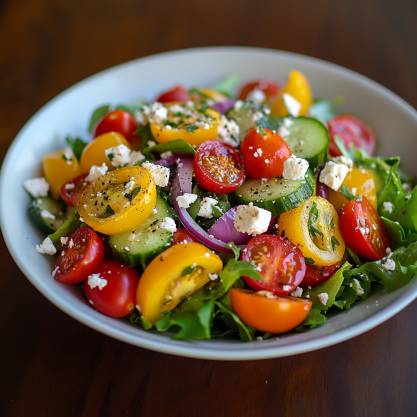
Ingredients
- 4 cups mixed salad greens
- 1 cucumber, sliced
- 1 cup cherry tomatoes, halved
- 1 bell pepper, diced
- 1/4 red onion, thinly sliced
- 1/4 cup olive oil
- 2 tablespoons vinegar (balsamic or apple cider)
- Salt and pepper to taste
- Optional: 1/4 cup crumbled feta cheese
Instructions
- Wash all vegetables thoroughly
- Tear greens into bite-sized pieces
- Combine greens, cucumber, tomatoes, pepper, and onion in the bowl
- Mix oil, vinegar, salt, and pepper in the jar
- Shake dressing well and drizzle over salad
- Toss gently to coat
- Top with feta if desired
This salad is a great base for adding your favorite farmers market finds. Mix in seasonal produce to make it your own. Enjoy your fresh, homemade garden salad!
Step-by-Step Assembly Guide
Creating easy summer meals starts with mastering the art of salad assembly. This guide will help you turn vibrant salad ingredients into a feast for both the eyes and taste buds.
Washing and Preparation
Start by thoroughly rinsing all produce under cool running water. Pat dry with clean towels or use a salad spinner. Chop vegetables into bite-sized pieces for easy eating. Prep proteins like grilled chicken or hard-boiled eggs in advance for quicker assembly.
Layering for Visual Appeal
Build your salad from the bottom up:
- Start with a base of crisp greens
- Add colorful vegetables in rainbow order
- Sprinkle in proteins for substance
- Top with crunchy elements like nuts or croutons
- Drizzle dressing just before serving
This method ensures each bite is packed with flavor and texture, making your garden salad a standout among easy summer meals.
Timing and Storage
For peak freshness, assemble your salad right before eating. If prepping ahead, layer hearty ingredients at the bottom and delicate ones on top. Store undressed salads in airtight containers in the fridge for up to 3 days. Keep dressing separate to prevent wilting.
“A well-assembled salad is a work of art, reflecting the colors of the season and the care of its creator.”
With these tips, you’ll create stunning salads that showcase the best vibrant salad ingredients summer has to offer.
Seasonal Variations and Substitutions
Garden salads are best when made with the freshest ingredients. Using seasonal produce lets you mix up flavors all year. Let’s see how to change up your salad with the seasons.
Spring Delights
Spring brings tender greens and bright veggies. Mix arugula, spinach, and watercress with radishes and sweet peas. Add edible flowers for color. These ingredients make a light, refreshing salad for warm days.
Summer Bounty
Summer is full of fresh produce. Use juicy tomatoes, crisp cucumbers, and sweet bell peppers as a base. Add fresh herbs like basil or mint for flavor. Grilled corn or blanched green beans add protein.
Year-round Options
Even in cold months, you can still make great salads. Use hardy veggies like roasted beets, shredded carrots, and cabbage. Try adding crisp apples or juicy pears for sweetness.
“The secret to a great salad is using what’s fresh and in season. Let the produce guide your choices,” says Chef Maria Rodriguez.
Your local farmers market is full of seasonal ideas. Every visit brings new ingredients and salad combinations to try.
Nutritional Benefits and Dietary Information
Garden salads are full of vitamins and minerals. They are a tasty way to get more nutrients every day. Leafy greens like spinach and kale give you iron and calcium. Colorful veggies add vitamins A and C to your meals.
These salads are also good for your digestive health. They make you feel full for longer. Raw veggies in salads keep more nutrients than cooked ones, making them a great choice.
- Vitamin A: Supports eye health and immune function
- Vitamin C: Boosts collagen production and aids in iron absorption
- Fiber: Promotes digestive health and helps manage weight
- Antioxidants: Protect cells from damage and support overall health
Our garden salad recipe is easy to change for different diets. For vegans, skip the cheese and add nuts or seeds for protein. Gluten-free eaters can enjoy it as is. Low-carb dieters can focus on leafy greens and limit higher-carb veggies.
“Eating a variety of colorful vegetables in your salads is like consuming a natural multivitamin,” says nutritionist Sarah Thompson.
Adding these healthy salad recipes to your meals does more than just taste good. They nourish your body with vital nutrients. This supports your health and well-being.
Conclusion
Making a garden salad is a fun way to enjoy summer’s fresh foods. It’s a mix of tasty flavors, textures, and nutrients. Our guide will help you make salads that are both delicious and healthy.
One of the best things about garden salads is how easy they are to change up. Try new ingredients, different dressings, or add proteins and fruits. There’s no limit to what you can create!
We hope this recipe makes you want to include garden salads in your summer meals. They’re a simple way to eat well and enjoy the season’s best. So, get your salad bowl ready, pick some fresh ingredients, and start making your own garden salad wonders. Your taste buds and body will love it!

